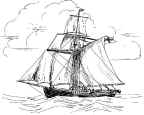|
Jakob Anderson Slogvig
(Slogvik) and his wife
Serena (Serine)
Tormodsdatter Madland were both born in the early 1800's in
southwestern Norway. As young people they were aboard the small sloop Restoration
which Jakob, taking the Americanized name of Jacob Anderson, married Serena in upstate New York where these emigrants first settled. He moved his family west in the 1830's to be one of the first families to settle in the historically significant Fox River Settlement of Illinois. In 1848 they moved farther west to southwestern Iowa where they had a large fertile farm. In 1854 the family moved west again, this time to Soscol, an early community just south of the town of Napa in northern California. Here Jacob developed a new farm and lived there with his family until his death in 1864. He was buried in the Tulocay Cemetery in the town of Napa. In his 1961 book, The Sloopers, J. Hart Rosdail points out that Jacob died "farther from his native Norway than any other who came over on the Sloop" (p. 425). [See Map for westward movement.] New information obtained in 2003 provided more information about the land purchased by this family in southern Napa County during the 1950's and 1960's. Search for land records and information about this family's life during this time period continue, but current information and current area photos can be viewed by starting with the new "Napa Area Land Map Page." After Jacob's death Serena lived mostly with their son Andrew and his wife Melissa. After living in several parts of Iowa and California, Serena died in 1898 on the large Anderson ranch in the Sacramento Valley of northern California, west of the town of Willows. Serena was laid to rest beside her husband and youngest son in the Napa Tulocay Cemetery. Visiting this Napa cemetery prior to May 2004, one found one simple stone for these 3 members of this historic family. It was a large plot with room for more burials, but the descendants moved from this area and subsequent families have chosen not to be buried here. [The location is: Block 49, Lot 19 (book 2, p. 64); Lot purchased by their daughter, Martha Wheeler.] While the engraving on the stone stated that both Jacob and Serene were born in Norway, there was no further indication that they were pioneers in Norwegian-American immigration. Sloopers Jacob and Serena are the great great grandparents of Keith Wheeler of Mad River, California, USA, just one of their many descendants. For more information on these Sloopers and the family connections, visit Keith's Slooper Ancestors web page. For photos of just some of their descendants gathering for a California reunion, see the "Slooper Picnic 2002" albums. |
 sailed in 1825 with a group of emigrants from Norway to America.* The
Restoration (
sailed in 1825 with a group of emigrants from Norway to America.* The
Restoration (